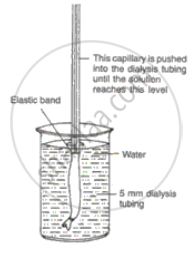Advertisements
Advertisements
प्रश्न
Minerals cannot be passively absorbed by the roots.
उत्तर
The minerals cannot be passively absorbed by the roots because:
- The minerals are present in the soil as charged particles (ions) and cannot move across the cell membrane.
- The concentration of minerals in the soil is lower than the concentration of minerals in the root.
APPEARS IN
संबंधित प्रश्न
Draw a magnified view of the root-hair, and describe, how it helps in the absorption of water from the soil.
What would happen to the root hair of a potted plant if the soil was watered with an extremely concentrated solution of sodium chloride?
The apparatus arranged alongside signifies an important process.
(i) Name the process.
(ii) Where does this process occur in plants?
(iii) What solution is placed inside the dialysis tubing?
(iv) What happens to the level of the solution in the capillary tube?

The diagram given below represents the results of an experiment conducted on two freshly taken leafy shoots of a herbaceous plant. The lower ends of the shoots dip in ordinary water.
(i) What is the aim of the experiment?
(ii) Some parts of the stem in both the shoots have been removed. Name the conducting tissue in shoot (a) and in shoot (b) that has been removed.
(iii) What are the results of this experiment?

How is root hair structurally adapted for absorption of water from the soil?
Give Technical Term for the following.
Phenomenon of absorption of water by surface attraction.
Column ‘II’ is a list of items related to ideas in Column ‘I’. Match the term in Column ‘II’ with a suitable idea given in Column ‘I’.
| Column I | Column II |
| (i) Diffusion | (a) The exit or flow of water from the cell to the outer environment. |
| (ii) Xylem | (b) The shrinkage of protoplasm when the cell is kept in a hypertonic solution. |
| (iii) Root pressure | (c) The tissue through which water and mineral salts move upward in a plant. |
| (iv) Isotonic solution | (d) Two solutions which have equal osmotic pressure. |
| (v) Exosmosis | (e) The process by which the molecules of perfume spread in the room when the bottle is open. |
| (vi) Osmosis | (f) The process by which roots absorb water from the soil. |
| (vii) Plasmolysis | (g) The pressure by which water rises up to some feet in a lofty tree. |
| (viii) Hypotonic solution | (h) The concentration of the solution when lower than that of the cell sap. |
Trace the pathway followed by water molecules from the time it enters a plant root to the time it escapes into the atmosphere from a leaf.
What would happen to the leaves of a plant that transpires more water than its absorption in the roots?
____________plants like orchids absorb water vapours from air with the help of epiphytic roots having special tissue called velamen.
